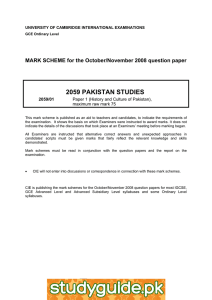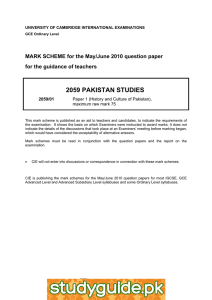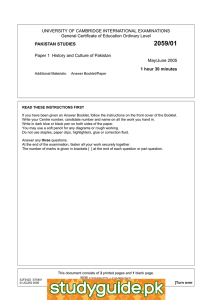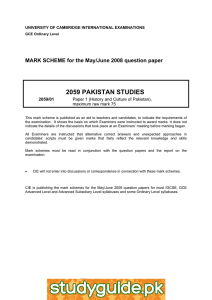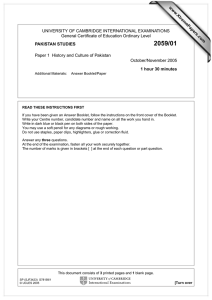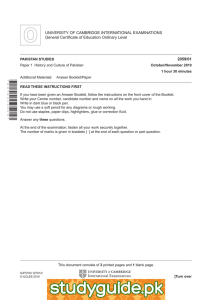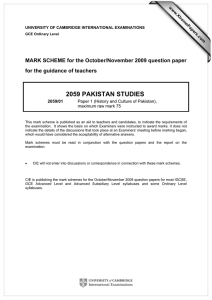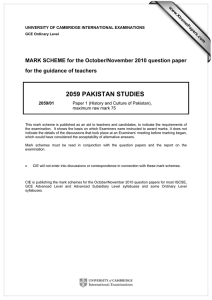2059 PAKISTAN STUDIES MARK SCHEME for the October/November 2008 question paper
advertisement
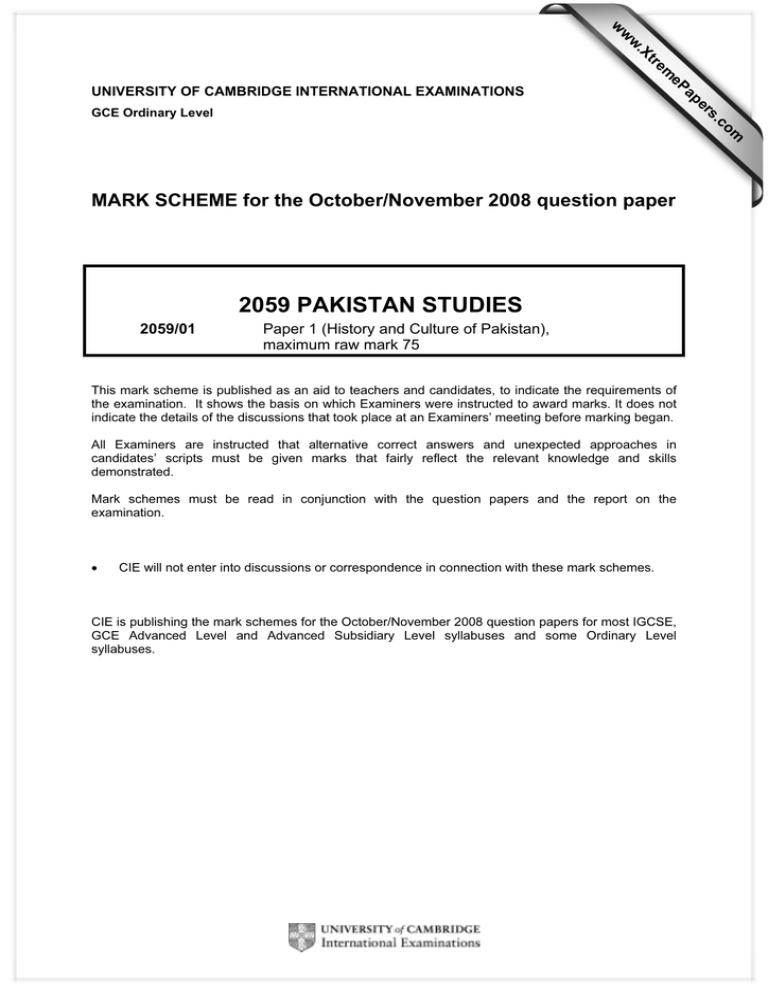
w w ap eP m e tr .X w UNIVERSITY OF CAMBRIDGE INTERNATIONAL EXAMINATIONS s er om .c GCE Ordinary Level MARK SCHEME for the October/November 2008 question paper 2059 PAKISTAN STUDIES 2059/01 Paper 1 (History and Culture of Pakistan), maximum raw mark 75 This mark scheme is published as an aid to teachers and candidates, to indicate the requirements of the examination. It shows the basis on which Examiners were instructed to award marks. It does not indicate the details of the discussions that took place at an Examiners’ meeting before marking began. All Examiners are instructed that alternative correct answers and unexpected approaches in candidates’ scripts must be given marks that fairly reflect the relevant knowledge and skills demonstrated. Mark schemes must be read in conjunction with the question papers and the report on the examination. • CIE will not enter into discussions or correspondence in connection with these mark schemes. CIE is publishing the mark schemes for the October/November 2008 question papers for most IGCSE, GCE Advanced Level and Advanced Subsidiary Level syllabuses and some Ordinary Level syllabuses. Page 2 1 (a) Mark Scheme GCE O LEVEL – October/November 2008 Syllabus 2059 Paper 01 (i) After winning the Battle of Plassey in 1757, what did Robert Clive become? Governor of Bengal [1] (ii) Name Haji Shariat Ullah’s son who carried on his work after his death in 1840. Mohsin-ud-Din [1] (iii) In which year did the Amirs of Sindh attack the British Residency of Sir Charles Napier? 1843 [1] (iv) What did Sir Syed Ahmad Khan establish in 1863? Scientific Society at Ghazipore [1] (b) Explain why the successors of Aurangzeb failed to prevent the decline of the Mughal Empire. LEVEL 1: Simplistic statement [1] They weren’t any good as rulers. LEVEL 2: Identifies reasons [2–4] Aurangzeb’s successors were weak. There was no law of succession. LEVEL 3: Explains reasons [5–7] Aurangzeb’s successors tended to be lazy, weak and corrupt, leaving the administration to their ministers who often put their own interests first. There was no law of succession. Instead there was usually a struggle for succession which ended in war. Succession often depended upon the ability of the candidates and the support they could get. Fighting wars was very expensive and the military was stretched and suffered much inefficiency. These emperors failed to run the Empire effectively, becoming very extravagant and so suffered from financial inefficiencies. The vastness of the Empire made it hard to defend and as such suffered several invasions from stronger rivals. Eventually the British overran the Empire and were superior in such areas as military might. (c) ‘Religious factors were more important than any other in causing the War of Independence of 1857–1858.’ Do you agree? Give reasons for your answer. LEVEL 1: Simplistic statement. [1–2] The British were resented. LEVEL 2: Description of religious or other causes [3–6] Christianity was taught in schools. LEVEL 3: Explains one factor [7–10] © UCLES 2008 Page 3 Mark Scheme GCE O LEVEL – October/November 2008 Syllabus 2059 Paper 01 LEVEL 4: Explains at least two factors. English to be explained for maximum marks. [9–13] Christian missionaries came to India to convert the local population as well as set up schools. In these schools the missionaries taught Christianity and expected local religions to be given up which was resented by Muslims, Hindus and Sikhs alike. The replacement of Persian and Sanskrit by English as the official language in the 1830s deeply upset both the Muslims and Hindus. A number of social reforms had been imposed by the British without consultation or care for local feeling which caused much unrest. Indians had to send their children to co-educational schools which was hated since it appeared to impose the British system on the Indians without due regard to their religious and cultural feelings. They were also forced to abandon purdha which had been an Indian custom for centuries. The ‘Doctrine of Lapse’ caused great unrest because any local kingdom not having a direct male heir was taken over by the British. A new cartridge was introduced by the British which was coated in both cow and pig fat. Because the soldiers had to chew the fat, this caused great resentment since pig fat was forbidden by the Muslims while the cow was a sacred animal in the eyes of the Hindus. LEVEL 5: As Level 4 – also produces a judgement or evaluation. 2 (a) [14] (i) What was founded in 1885 as a result of conferences in Bombay and Calcutta? (Indian National) Congress [1] (ii) Who was imprisoned in 1897 as a result of writing a newspaper article? Bal Gangadhar Tilak of Poona [1] (iii) What name was given to the unsuccessful plot in which anti-British Muslims suggested an uprising by the Muslims to free them from British rule during the First World War (1914-1918)? Silk Letters Conspiracy [1] (iv) Where was the meeting held in 1919 that was bombed from the air? Gujranwalla (or Gujranwala) [1] (b) Why did Congress oppose the Morley-Minto Reforms of 1909? LEVEL 1: Simplistic statement [1] They were against them. LEVEL 2: Identifies reasons [2–4] Because of separate electorates and lack of self rule. © UCLES 2008 Page 4 Mark Scheme GCE O LEVEL – October/November 2008 Syllabus 2059 Paper 01 LEVEL 3: Explains reasons [5–7] The British intended that the Indians could voice their opinions in the Councils but Congress wanted more responsibility which the government were not prepared to give. This annoyed many who were looking towards self-rule. The British accepted the right of Muslims to have separate electorates which also annoyed some Hindus who saw it as a concession too far. Some Hindus also resented the relative high position of Muslims in the Councils despite their much smaller numbers. (c) ‘The Khilafat Movement failed by 1924 because of poor leadership.’ Do you agree? Give reasons for your answer. LEVEL 1: Simplistic statement [1–2] It was because of poor leadership. LEVEL 2: Description of Movement/poor leadership or other factors [3–6] Gandhi withdrew his support and because of the Chaura Chari incident. LEVEL 3: Explains at least one factor [7–10] LEVEL 4: Explains at least two factors, poor leadership to be explained for maximum marks. [9–13] Some of the leaders including Maulana Muhammad Ali were imprisoned in 1921 which made the organisation less effective. Also by joining with Hindus, the objectives of the Movement were made less clear since Hindus, and Ghandi especially, were seen as using it for their own ends and, it was thought, didn’t have the interests of Muslims at heart. Gandhi decided that the Swaraj Movement was becoming too violent following the Chaura Chari incident and so called off his support. In 1920 the Muslim migration (hijrat) to Afghanistan took place. The Muslim League opposed this as they wanted people to stay and fight for their cause. The migration was a failure. The Afghan government was hostile to the migrants who on their return found their homes and jobs occupied, which dispirited the Muslims. Finally, the new Turkish government under Kemal Ataturk abolished the institution of the Caliph in 1924, so ending the Movement. LEVEL 5: As Level 4 – also produces a judgement or evaluation 3 (a) [14] (i) Name a Hindu fundamentalist movement that carried out military activities in the Punjab during 1924. Arya Samaj. Also allow Hidu Mahasabha. [1] (ii) What did Gandhi embark upon in March 1930? Salt March [1] © UCLES 2008 Page 5 Mark Scheme GCE O LEVEL – October/November 2008 Syllabus 2059 Paper 01 (iii) What was signed on 5th March 1931? Gandhi-Irwin Pact [1] (iv) When did Jinnah become permanent president of the Muslim League? 1934 [1] (b) Why was there so much opposition to the Government of India Act of 1935? LEVEL 1: Simplistic statement [1] It wasn’t liked. LEVEL 2: Identifies reasons [2–4] The Viceroy and Governor-General was in total control and few Indians could vote. LEVEL 3: Explains reasons [5–7] The Viceroy and Governor-General was head of the Federation and could exert special powers if he wanted to. Provincial governors also had special powers, having the right to dismiss ministers or the whole administration. Only 25% of India’s population could vote because of the property qualification for voting. Therefore few could vote. All sides in India opposed it from princes to Congress to The Muslim League, so there was little progress in gaining support. (c) Was the Cripps Mission in 1942 the most important factor during the 1940s that led to the partition of the sub-continent in 1947? Give reasons for your answer. LEVEL 1: Simplistic statement [1–2] There were lots of factors. LEVEL 2: Description of Cripps Mission or other factors during 1940s [3–6] Cripps went to India to gain support for the war effort in return for a number of promises. Gandhi and Jinnah held talks about a Muslim homeland. The Muslim League and Congress met the Viceroy of India at Simla. LEVEL 3: Explains at least one factor [7–10] LEVEL 4: Explains at least two factors. Cripps Mission to be explained for maximum marks [9–13] Cripps went to India to gain support for the war effort in return for a number of promises including Dominion Status after the War had ended. The Muslim League rejected the plan because the British would not agree to Partition while Congress wanted immediate and full control over the central government. The British were also negotiating from a weak position which Congress exploited by demanding that Britain leave the sub-continent immediately. © UCLES 2008 Page 6 Mark Scheme GCE O LEVEL – October/November 2008 Syllabus 2059 Paper 01 Gandhi and Jinnah held talks about a Muslim homeland but failed to reach agreement since Jinnah wanted six provinces included in Pakistan whereas Gandhi only agreed to three. Nevertheless, it was an important meeting since Gandhi had negotiated with the Muslim League on an equal footing for the first time. However, Cripps was not the only factor which was important in leading to eventual Partition. At the Simla Conference, the Viceroy realised that the two parties were unable to reach agreement on anything. Although all parties agreed to the principle of the Executive Council, the sticking point was the method of selection. Following the Conference, Lord Wavell announced new elections. The results demonstrated that Congress had control of the non-Muslim vote, but that the League had gained control of the Muslim vote. It was clear that the League was an equal player to Congress and that the demand for Partition could no longer be ignored by Congress or the British Government. However, it was following the announcement by Attlee that the British would leave the subcontinent by 1948, and the subsequent violence in the Punjab in March 1947, that convinced Nehru that Partition should take place. This was formalised in the 3 June Plan. LEVEL 5: As Level 4 – also produces a judgement or evaluation. 4 (a) [14] (i) How many princely states were told by Lord Mountbatten that they would not be granted independence? 462 [1] (ii) Name the Hindu ruler of Kashmir in 1947. Hari Singh [1] (iii) Who became Governor-General of Pakistan in September 1948 on the death of the Quaid? Khawaja Nazimuddin [1] (iv) Name the organisation that presented the draft constitution to the Pakistan Assembly in 1950. Basic Principles Committee [1] (b) Why did East Pakistan wish to become independent of West Pakistan? LEVEL 1: Simplistic answer [1] It saw no alternative. LEVEL 2: Identifies reasons [2–4] It was a long way from West Pakistan and was poorer. © UCLES 2008 Page 7 Mark Scheme GCE O LEVEL – October/November 2008 Syllabus 2059 LEVEL 3: Explains reasons Paper 01 [5–7] East Pakistan was resentful of the fact that it was under-represented in the Pakistani army and the Civil Service. Due to the distance from the West, it felt that it was under political repression and with an undemocratic government. Because it had a weaker industrial base than the West and suffered from floods, it resented that it received little attention from the rest of Pakistan. (c) ‘Education reforms were the most important of Zulfiqar Ali Bhutto’s domestic policies between 1971 and 1977.’ Do you agree? Give reasons for your answer. LEVEL 1: Simplistic statement [1–2] Schools were built. LEVEL 2: Description of education reforms or other domestic policies [3–6] He introduced free primary education and rural health centres. LEVEL 3: Explains at least one factor [7–10] LEVEL 4: Explains at least two. Education reforms to be explained for maximum marks [9–13] Amongst Bhutto’s education reforms, free primary education was introduced. New schools were to be built and all private sector schools were nationalised. The aim was to increase the literacy rate and raise academic standards. The changes in education led to overcrowding in existing schools whist new ones could be built. The reforms were not very successful since the building of new schools and the recruitment of new teachers could not be achieved quickly and was also very expensive. Many families resented the educational reforms since it meant a loss of earnings to them. However other aspects of his domestic policies were also important. He also tried to improve the infant mortality and age expectancy rates by introducing Rural Health Centres and Basic Health Units. Pharmaceutical companies were banned from charging for a particular medical brand name and so medicines became cheaper. However this did see the profits of chemists fall drastically and many international drug companies closed down their operations in Pakistan. A new constitution drawn up in 1973 established a senate which offered the opportunity for professionals, academics and specialists to work together. It also safeguarded the interests of minority provinces which now had an equal status in the Senate. He produced the 1973 Constitution in an attempt to return to a form of parliamentary democracy and it was important since it is the basis upon which Pakistan has been governed to the end of the 20th Century (apart from when it was suspended due to martial law). One of the main weaknesses of the new constitution was that the focal point of political power lay with the party leadership, and Bhutto in particular. When things went wrong, the blame was clearly laid at his feet. LEVEL 5: As Level 4 – also produces a judgement or evaluation. © UCLES 2008 [14] Page 8 5 (a) Mark Scheme GCE O LEVEL – October/November 2008 Syllabus 2059 Paper 01 (i) Who was dismissed as Prime Minister by Iskander Mirza in 1955? Ali Bogra [1] (ii) Who did Ayub Khan appoint as the Rehabilitation Minister during the ‘Decade of Development’? General Azam Khan [1] (iii) What law did Zia ul-Haq introduce to establish military courts to try offenders according to martial law in 1979? Constitution (Amendment) Act [1] (iv) Who became acting President of Pakistan on the death of Zia ul-Haq in 1988? Ghulam Ishaq Khan [1] (b) Why did Pakistan support the Palestinian cause between 1947 and 1988? LEVEL 1: Simplistic answer [1] It felt that it was important to Pakistan. LEVEL 2: Identifies reasons [2–4] They are Muslims and because of the fire in the Al-Aqsa Mosque. LEVEL 3: Explains reasons [5–7] Pakistanis identify themselves with the Palestinians as fellow Muslims who should be supported in their Cause. The objective of the OIC, of which Pakistan is a member, is to promote harmony and co-operation between Muslim nations. The incident of the Al-Aqsa Mosque was discussed at the first meeting of the OIC and support offered to the Palestinians. At the Second Conference in 1974, more specific support was forthcoming. (c) How successful was Pakistan in its relationship with India between 1947 and 1988? LEVEL 1: Simplistic statement [1–2] Relations between the two nations have been very poor. LEVEL 2: Description of relationship [3–6] Outlines the Kashmir Crisis and the Wars in 1965 and 1971; nuclear tests in 1974. LEVEL 3: Explains the successes OR failures © UCLES 2008 [7–10] Page 9 Mark Scheme GCE O LEVEL – October/November 2008 Syllabus 2059 LEVEL 4: Explains the successes AND failures Paper 01 [9–13] Successes Agreement regarding border between East Bengal and Assam 1948 Minorities Agreement 1950 Simla Accord 1972 Failures Kashmir 1965 and 1971 Wars Nuclear arms race Aftermath of Indira Gandhi’s assassination LEVEL 5: As Level 4 – also produces a judgement or evaluation. © UCLES 2008 [14]
